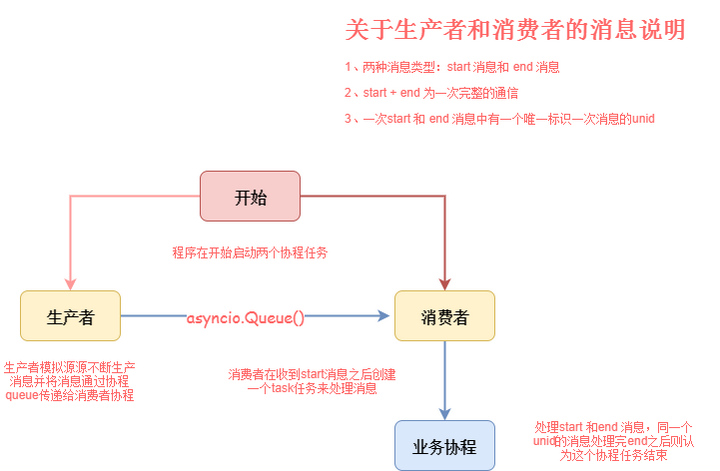关于asyncio知识(四)
一、使用 asyncio 总结
最近在公司的一些项目中开始慢慢使用python 的asyncio, 使用的过程中也是各种踩坑,遇到的问题也不少,其中有一次是内存的问题,自己也整理了遇到的问题以及解决方法详细内容看:https://www.syncd.cn/article/memory_trouble
在前面整理的三篇asyncio文章中,也都是使用asyncio的一些方法,但是在实际项目中使用还是避免不了碰到问题, 在这周的工作中遇到之前碰见过的问题,一个初学asyncio写代码中经常会碰到的问题,我的业务代码在运行一段时间后提示如下错误提示:
Task was destroyed but it is pending!task: <Task pending coro=<HandleMsg.get_msg() done, defined at ex10.py:17> wait_for=<Future cancelled>>
这个错误我在前面几篇关于asyncio的系列文章中也反复说过这个问题,我也认为自己不会在出现这种问题,但是意外的是,我的程序还是出现了这个错误。
我将我的业务代码通过一个demo代码进行模拟复现以及解决这个问题,下面整理的就是这个过程
二、“Task was destroyed but it is pending!”
我通过下面这张图先描述一下demo程序的逻辑:

import asyncio
from asyncio import Queue
import uuid
from asyncio import Lock
from asyncio import CancelledError
queue = Queue()
class HandleMsg(object):
def __init__(self, unid, coroutine_queue, handle_manager):
self.unid = unid
self.coroutine_queue = coroutine_queue
self.handle_manager = handle_manager
async def get_msg(self):
while True:
coroutine_msg = await self.coroutine_queue.get()
msg_type = coroutine_msg.get("msg")
if msg_type == "start":
print("recv unid [%s] is start" % self.unid)
else:
print("recv unid [%s] is end" % self.unid)
# 每个当一个unid收到end消息为结束
await self.handle_manager.del_unid(self.unid)
class HandleManager(object):
"""
用于unid和queue的关系的处理
"""
def __init__(self):
self.loop = asyncio.get_event_loop()
self.lock = Lock(loop=self.loop)
self.handle_dict = dict()
async def unid_bind(self, unid, coroutine_queue):
async with self.lock:
self.handle_dict[unid] = coroutine_queue
async def get_queue(self, unid):
async with self.lock:
if unid in self.handle_dict:
return self.handle_dict[unid]
async def del_unid(self, unid):
async with self.lock:
if unid in self.handle_dict:
self.handle_dict.pop(unid)
def make_uniqueid():
"""
生成unid
"""
uniqueid = str(uuid.uuid1())
uniqueid = uniqueid.split("-")
uniqueid.reverse()
uniqueid = "".join(uniqueid)
return uniqueid
async def product_msg():
"""
生产者
"""
while True:
unid = make_uniqueid()
msg_start = {"unid": unid, "msg": "start"}
await queue.put(msg_start)
msg_end = {"unid": unid, "msg": "end"}
await queue.put(msg_end)
loop = asyncio.get_event_loop()
await asyncio.sleep(0.2, loop=loop)
async def consumer_from_queue(handle_manager):
"""
消费者
"""
while True:
msg = await queue.get()
print("consumer recv %s" % msg)
msg_type = msg.get("msg")
unid = msg.get("unid")
if msg_type == "start":
coroutine_queue = Queue() # 用于和handle_msg协程进行数据传递
handle_msg = HandleMsg(unid, coroutine_queue, handle_manager)
await handle_manager.unid_bind(unid, coroutine_queue)
await coroutine_queue.put(msg)
loop = asyncio.get_event_loop()
# 每次的start消息创建一个task 去处理消息
loop.create_task(handle_msg.get_msg())
else:
coroutine_queue = await handle_manager.get_queue(unid)
await coroutine_queue.put(msg)
if __name__ == "__main__":
loop = asyncio.get_event_loop()
handle_manager = HandleManager()
# 在最开始创建了两个task 分别是生产者和消费者
loop.create_task(product_msg())
loop.create_task(consumer_from_queue(handle_manager))
loop.run_forever()
上面的代码表面上看没啥问题,我们先看看运行效果:
consumer recv {'unid': '784f436cfaf388f611e94ca974e1ffbe', 'msg': 'start'}
consumer recv {'unid': '784f436cfaf388f611e94ca974e1ffbe', 'msg': 'end'}
Task was destroyed but it is pending!
task: <Task pending coro=<HandleMsg.get_msg() done, defined at demo.py:17> wait_for=<Future cancelled>>
Task was destroyed but it is pending!
task: <Task pending coro=<HandleMsg.get_msg() done, defined at demo.py:17> wait_for=<Future cancelled>>
Task was destroyed but it is pending!
task: <Task pending coro=<HandleMsg.get_msg() done, defined at demo.py:17> wait_for=<Future cancelled>>
Task was destroyed but it is pending!
task: <Task pending coro=<HandleMsg.get_msg() done, defined at demo.py:17> wait_for=<Future cancelled>>
Task was destroyed but it is pending!
task: <Task pending coro=<HandleMsg.get_msg() done, defined at demo.py:17> wait_for=<Future cancelled>>
Task was destroyed but it is pending!
task: <Task pending coro=<HandleMsg.get_msg() done, defined at demo.py:17> wait_for=<Future cancelled>>
..........
程序没运行一段时间都会出现上面显示的错误提示,我先看看错误提示的信息:
Task was destroyed but it is pending!task: <Task pending coro=<HandleMsg.get_msg() done, defined at demo.py:17> wait_for=<Future cancelled>>
上面提示的其实就是我的task 是在pendding状态的时候被destroyed了,代码行数以及调用方法都告诉我们了是在:HandleMsg.get_msg() done, defined at demo.py:17
其实问题也比较好找,我们为每个unid创建了一个task来处理消息,但是当我们收到每个unid消息的end消息之后其实这个task任务对于我们来说就已经完成了,同时我们删除了我的unid和queue的绑定,但是我们并没有手动去取消这个task。
注意:这里我其实也有一个不理解的地方:关于这个task为什么会会destroyed,这个协程里是一个死循环一直在收消息,当queue里面没有消息协程也应该一直在await 地方在等待才对,但是如果我们把收到end消息的那个地方的删除unid和queue的绑定关系不删除,那么这个任务是不会被descroyed。所以没有完全明白这里的机制,如果明白的同学欢迎留言讨论
但是即使上面的机制我们有点不是特别明白,我们其实也应该把这个task手动进行cancel的,我们们将上面的代码稍微进行改动如下:
async def get_msg(self):
try:
while True:
coroutine_msg = await self.coroutine_queue.get()
msg_type = coroutine_msg.get("msg")
if msg_type == "start":
print("recv unid [%s] is start" % self.unid)
else:
print("recv unid [%s] is end" % self.unid)
# 每个当一个unid收到end消息为结束
await self.handle_manager.del_unid(self.unid)
current_task = asyncio.Task.current_task()
current_task.cancel() # 手动cancel 当前的当前的task
except CancelledError as e:
print("unid [%s] cancelled success" %self.unid)
这里有个问题需要注意就是当我们对task进行cancel的时候会抛出cancelledError异常,我们需要对异常进行处理。官网也对此进行专门说明:
https://docs.python.org/3.6/library/asyncio-task.html#coroutine
内容如下:
cancel()
Request that this task cancel itself.
This arranges for a CancelledError to be thrown into the wrapped coroutine on the next cycle through the event loop. The coroutine then has a chance to clean up or even deny the request using try/except/finally.
Unlike Future.cancel(), this does not guarantee that the task will be cancelled: the exception might be caught and acted upon, delaying cancellation of the task or preventing cancellation completely. The task may also return a value or raise a different exception.
Immediately after this method is called, cancelled() will not return True (unless the task was already cancelled). A task will be marked as cancelled when the wrapped coroutine terminates with a CancelledError exception (even if cancel() was not called).
三、小结
虽然还有一些地方不太明白,但是随着用的越多,碰到的问题越多,一个一个解决,可能现在对某些知识还有点模糊,但是至少比刚开始使用asyncio的时候清晰了好多,之前整理的三篇文章的连接如下:
https://www.syncd.cn/article/asyncio_article_01
https://www.syncd.cn/article/asyncio_article_02
https://www.syncd.cn/article/asyncio_article_03
也欢迎加入交流群一起讨论相关内容:948510543
关于asyncio知识(四)的更多相关文章
- Python基础知识(四)
Python基础知识(四) 一丶列表 定义格式: 是一个容器,由 [ ]表示,元素与元素之间用逗号隔开. 如:name=["张三","李四"] 作用: 存储任意 ...
- 关于asyncio知识(二)
一.asyncio之—-入门初探 通过上一篇关于asyncio的整体介绍,看过之后基本对asyncio就有一个基本认识,如果是感兴趣的小伙伴相信也会尝试写一些小代码尝试用了,那么这篇文章会通过一个简单 ...
- 关于asyncio知识(一)
一.介绍 asyncio 是python3.4 引入的一个新的并发模块,主要通过使用coroutines 和 futures 来让我们更容易的去实现异步的功能,并且几乎和写同步代码一样的写代码,还没有 ...
- C# 基础知识 (四).C#简单介绍及托管代码
暑假转瞬即逝,从10天的支教生活到1周的江浙沪旅游,在这个漫长的暑假中我经历了非常多东西,也学到了非常多东西,也认识到了非常多不足之处!闲暇之余我准备又一次进一步巩固C#相关知识,包含 ...
- 关于asyncio知识一
一.介绍 asyncio 是python3.4 引入的一个新的并发模块,主要通过使用coroutines 和 futures 来让我们更容易的去实现异步的功能,并且几乎和写同步代码一样的写代码,还没有 ...
- Javascript知识四(DOM)
[箴 10:4] 手懒的,要受贫穷:手勤的,却要富足. He becometh poor that dealeth with a slack hand: but the hand of the di ...
- Java的基础知识四
一.Java 流(Stream).文件(File)和IO Java.io 包几乎包含了所有操作输入.输出需要的类.所有这些流类代表了输入源和输出目标. Java.io 包中的流支持很多种格式,比如:基 ...
- liunx 运维知识四部分
一. 权限介绍及文件权限测试 二. 目录权限测试 三. 默认控制权限umask 四. chown修改属性和属组 五. 网站安全权限介绍 六. 隐藏属性介绍 七. 特殊权限s 八. 特殊权限t 九. 用 ...
- Android学习之基础知识四-Activity活动7讲(活动的启动模式)
在实际的项目开发中,我们需要根据特定的需求为每个活动指定恰当的启动模式.Activity的启动模式一共有4种:standard.singleTop.singleTask.singleInstance. ...
随机推荐
- 输出日文CSV乱码问题
直接写用Excel打开时会乱码,需要加上下面代码中注释的三行 fos = new FileOutputStream(file, false); //fos.write( 0xef ); //fos.w ...
- Codeforces.226D.The table(构造)
题目链接 \(Description\) 给定一个\(n\times m\)的矩阵\(A_{i,j}\),每次可以将一列或一行取负.求一个方案使得若干次操作后,每行每列的和都非负. \(n,m\leq ...
- Max Factor 2710 最大的合数的质数因子
题目:http://acm.hdu.edu.cn/showproblem.php?pid=2710 思路:用类似“埃氏筛法”求素数的方法 只是不在把合数标记为1 而是标记为他是因子数. 最后比较大小即 ...
- windows提交代码到git仓库
进入git bash git config --global user.name '仓库名' git config --global user.email '2531099@163.com' git ...
- 超详细Gitlab Runner环境配置中文教程
配置GitlabRunner环境 GitLab Runner 是一个开源项目, 它用来运行你定制的任务(jobs)并把结果返回给 GitLab. GitLab Runner 配合GitLab CI(G ...
- 解决VS Code开发Python3语言自动补全功能不带括号的问题
Visual Studio Code(以下简称VS Code)用来开发Python3,还是很便利的,本身这个IDE就是轻量级的,才几十兆大小,通过安装插件的方式支持各种语言的开发.界面也美美哒,可以在 ...
- linux命令之kill篇
作业四:查询firewall进程,然后杀死 [root@localhost 桌面]# ps -aux |grep firewall root 772 0.0 2.0 327912 2 ...
- Grok patterns 汇总
S3_REQUEST_LINE (?:%{WORD:verb} %{NOTSPACE:request}(?: HTTP/%{NUMBER:httpversion})?|%{DATA:rawreques ...
- django之setting配置汇总
前面的随笔中我们经常会改setting配置也经常将一些配置混淆今天主要是将一些常见的配置做一个汇总. setting配置汇总 1.app路径 INSTALLED_APPS = [ 'django.co ...
- Mac 10.12下安装python3环境
python3感觉用虚拟环境会比较好操作一些,也不用直接卸载python2. 一.基于brew快速安装 # 安装python3 brew install python3 # 安装pip(好像3自带pi ...
